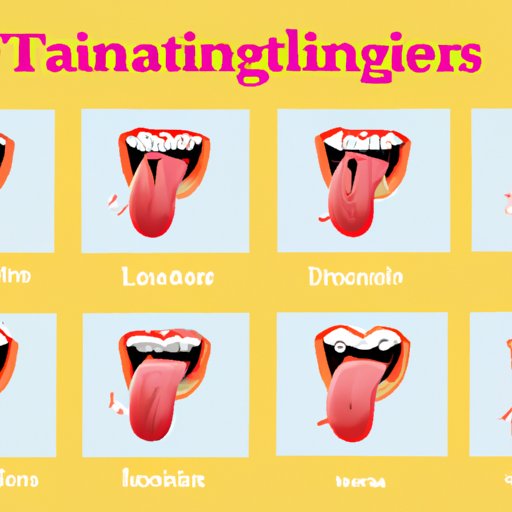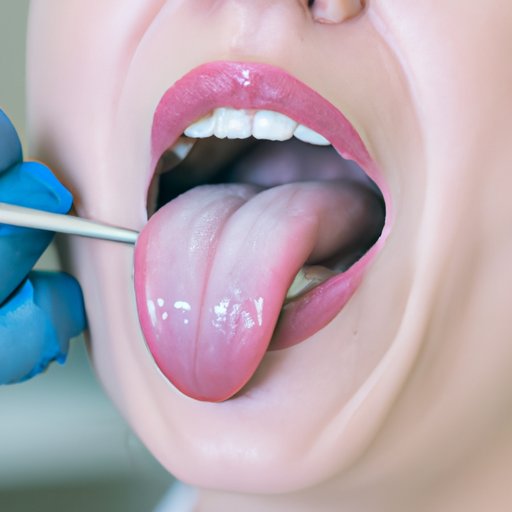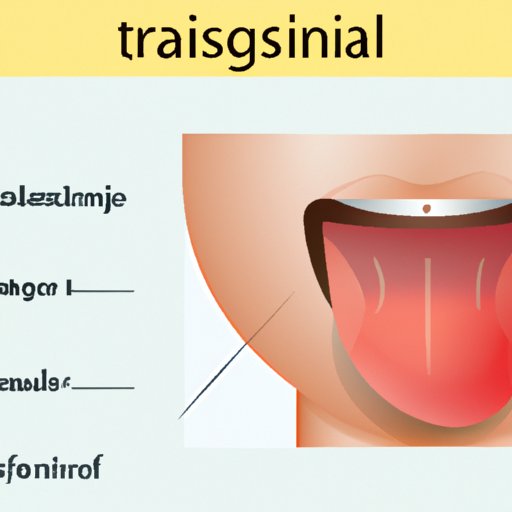Introduction
The tongue is an important part of the body, both in terms of taste and function. It helps us swallow, speak, and even breathe. As such, it’s important to pay attention to its health and appearance. But what should a healthy tongue look like?
A healthy tongue should be pink in color, moist, and relatively smooth. Its surface should also be free of any sores, patches, or discoloration, and it shouldn’t have any swelling or pain. However, there are many factors that can affect the appearance of a healthy tongue, including diet, hygiene, and medical conditions.
In this article, we’ll explore what a healthy tongue looks like, as well as common signs of an unhealthy tongue. We’ll also discuss how to evaluate your tongue for health, how diet and hygiene impact tongue health, the role of professional care in maintaining tongue health, and some home remedies for improving tongue health.
Examining the Anatomy of a Healthy Tongue
The tongue is made up of several parts, including the tip, sides, back, and root. The tip is the front part of the tongue, while the sides are the two edges that run along either side of the tongue. The back is the rear part of the tongue, and the root is the part that attaches the tongue to the floor of the mouth.
The surface of a healthy tongue should be relatively smooth, with no sores, patches, or discoloration. It should also be moist and pink in color. In addition, the tongue should have small bumps called papillae, which give it its rough texture. These papillae help the tongue to sense tastes, as well as move food around in the mouth.
There are several factors that can affect the appearance of a healthy tongue. Some of these include smoking, alcohol consumption, certain medications, and hormonal changes. In addition, certain medical conditions such as diabetes, anemia, and vitamin deficiencies can also affect the appearance of a healthy tongue.

Common Signs of an Unhealthy Tongue
While a healthy tongue should be pink in color, moist, and relatively smooth, there are several signs that may indicate an unhealthy tongue. These include:
Discoloration
A healthy tongue should be pink in color. However, if the tongue appears white, yellow, or black, this may be a sign of an underlying condition. White patches on the tongue can be a sign of oral thrush, while yellow patches can indicate jaundice. Black patches may be a sign of a bacterial or fungal infection.
Sores or Patches
The surface of a healthy tongue should be free of any sores or patches. However, if you notice any red or white spots on the tongue, this could be a sign of an infection or irritation. Sores or patches on the tongue can also be a sign of a more serious condition such as cancer.
Fissures or Cracks
Fissures or cracks in the tongue can be a sign of dehydration, vitamin deficiencies, or an underlying medical condition. These cracks can also be painful and make eating and speaking difficult.
Swelling
The tongue should not be swollen or enlarged. If the tongue is swollen, this can be a sign of an infection or allergic reaction. Swelling of the tongue can also be a sign of an underlying medical condition such as anemia or diabetes.
Pain
A healthy tongue should not be painful. Pain in the tongue can be a sign of an infection, injury, or allergy. It can also be a sign of an underlying medical condition such as oral thrush or an autoimmune disorder.
How to Evaluate Your Tongue for Health
It’s important to regularly check your tongue for any signs of an unhealthy tongue. You can do this by performing a self-examination in the mirror. Look at the color, texture, and size of your tongue, and check for any sores, patches, or discoloration. If you notice any of these signs, contact your doctor for a professional evaluation.

How Diet and Hygiene Impact Tongue Health
Your diet and hygiene habits can have a significant impact on your tongue health. Certain foods, such as spicy or acidic foods, can irritate your tongue and cause inflammation. It’s important to avoid these foods if you want to keep your tongue healthy.
In addition, proper oral hygiene is essential for maintaining tongue health. Brush your teeth twice a day, floss once a day, and use a tongue scraper to remove bacteria and debris from the surface of the tongue. This will help keep your tongue healthy and reduce the risk of infection.

The Role of Professional Care in Maintaining Tongue Health
Regular checkups with your dentist or primary care physician are important for ensuring good tongue health. During these appointments, your doctor will examine your tongue for any signs of an unhealthy tongue. Early detection and treatment of any issues can help prevent further complications.
Home Remedies for Improving Tongue Health
In addition to professional care, there are also several home remedies that can help improve tongue health. These include natural treatments such as drinking plenty of water and avoiding spicy or acidic foods, as well as herbal remedies such as gargling with salt water or using a mixture of honey and lemon juice.
Conclusion
The tongue is an important part of the body and it’s important to pay attention to its health and appearance. A healthy tongue should be pink in color, moist, and relatively smooth. Common signs of an unhealthy tongue include discoloration, sores or patches, fissures or cracks, swelling, and pain. Regular self-examinations, professional evaluations, and maintaining proper diet and hygiene habits can all help maintain tongue health.
In addition, there are also several home remedies that can help improve tongue health. These include natural treatments and herbal remedies. By following these tips, you can ensure that your tongue remains healthy and functioning properly.
(Note: Is this article not meeting your expectations? Do you have knowledge or insights to share? Unlock new opportunities and expand your reach by joining our authors team. Click Registration to join us and share your expertise with our readers.)
